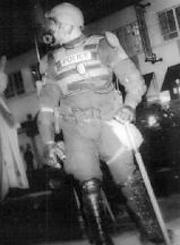THE LINE BETWEEN the police and the military has been blurring for years. Have you noticed how police SWAT teams have adopted US military-style helmets? Did you see the armored personnel carriers during the WTO protests?
If any question that the two seem to be merging remained, surely the famous photo of government agents seizing Elian Gonzalez creates an image that is apt: government employees resolving a child custody case at gunpoint in full combat regalia.
Increasingly, police departments around the country are receiving military-style training and being advised to acquire arsenals that are compatible with the military’s. And while civilian police departments are being militarized, the military itself is taking on law enforcement-style missions at home and abroad: peacekeeping in trouble spots, patrolling US borders, and hunting down drug smugglers.
A recent example is right here on Puget Sound. Last week Governor Gary Locke called in the National Guard to assist with tracking down, and shutting down, meth labs in Pierce County. We’re not talking civil unrest, fires, or floods: This is cop work, pure and simple. Locke defends this by saying meth labs are a health menace and that “we must all do whatever we can to stop this epidemic.” (Remember, this is an election year.) Guardsmen, in civilian clothes, will assist the police by doing investigative work and surveillance. Is this really the mission of the Guard? If Pierce County needs more cops, hire them.
Locke’s trigger-happiness with the Guard is indicative of the fact that many officials can no longer tell the difference between the mission of one organization and another, and that all civil emergencies are starting to look alike. Drug dealers and protesters, what’s the dif?
IF I SEEM HYPERSENSITIVE on this topic, it’s because I’m still reading through WTO postmortem reports, and I am deeply disturbed by what I see.
For example, there is Mayor Paul Schell’s consultant’s preliminary report on the WTO that was released at the end of April. As I warned in February (“Clean sweep or cover-up?” SW, 2/17), this report was likely to be highly slanted in its review of the WTO protests and planning process because the firm conducting it, R.M. McCarthy & Associates, is comprised of law enforcement heavies who specialize in “riot and crowd control.” And they didn’t disappoint.
This first report (and there will be a second, final one in July, the combined costing $100,000—nearly two-thirds of the City Council’s entire original WTO review budget) covers some of the same ground as the SPD’s own after-action critique. But these guys paint SPD and the mayor more harshly, almost as protester-coddling hippies. “Neither City government or the Police department had an obligation to welcome protesters and ensure their comfort,” the report says, calling meeting with and trying to accommodate some of the protester groups “ill-advised.” In fact, they conclude that protecting the rights of protesters was the only goal the WTO public safety committee accomplished. Funny, that. As thousands of locals were gassed and excluded from downtown’s no-protest zone, many had the distinct feeling their rights were being violated. I guess “violated” now means “protected,” the same way “peacekeeper” now means “missile.”
The consultants are outraged at Seattle’s onerous police surveillance ordinance and can’t understand how any serious policing can take place in a city that has one (what, no infiltration of political groups!?). And at the tail end of the report, they bash (who else?) the media: “The media, too, is accountable. While there were incidents of objective reporting, most coverage was inflammatory and at times irresponsible.” They offer not a single example. Certainly in the days leading up to the WTO, the coverage in the mainstream press was almost all boosterish of the WTO, free trade, and Christmas shopping: I found that pretty irresponsible, too, but I doubt we’re talking about the same thing.
Another group bears responsibility for the fiasco: “The people of Seattle who legitimately exercised their First Amendment rights, but refused to disperse and leave the area when ordered, thus preventing the police from making arrests and restoring order, also share in the responsibility for what subsequently occurred. Reasonable, law-abiding citizens do not remain to watch or participate in anarchy.” Wow. Apparently a lot of anarchists were in Seattle during the WTO—some of them in baby strollers at the Pike Place Market!
Another report, written by C.L. Staten, a national security analyst for the Emergency Response and Research Institute (which, by the way, did not respond to my call), is even more disturbing. In an analysis of the recent IMF/World Bank protests in Washington, DC, Staten suggests that protester tactics—the rather decentralized, mobile, hit-and-run methods used there and in Seattle—are an example of so-called “4th Generation” or “Asymmetric” warfare, first described in a 1989 Marine Corps Gazette article. In such warfare, “the battle is likely to be widely dispersed and largely undefined; the distinction between war and peace will be blurred to the vanishing point. It will be nonlinear . . . the distinction between ‘civilian’ and ‘military’ may disappear.” So that’s how some security analysts are seeing things: Seattle = Somalia.
As the lines between civilian and military blur, as cops and troops begin to merge, I guess it’s natural that lessons learned fighting enemies abroad might be applied on the home front. Those dancing sea turtles of November 30, they did kind of look like Third World warlords, didn’t they?
Visit Seattle Weekly’s Special Coverage: World Trade Organization.







